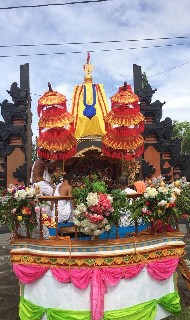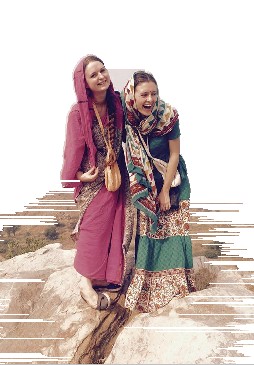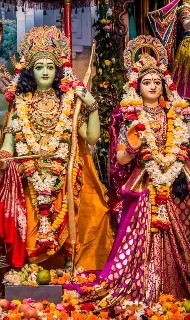(Kadamba Kanana Swami, 29 April 2011, Radhadesh, Belgium, Vyasa Puja Lecture)
Just now I came from South Africa and my spiritual master was also there and I met him. He was telling a nice story, which I’ll share with you. It was a story of the Ramayana. The Ramayana as we all know is an endless saga, there was great battle in Lanka to free Sita from captivity. Meanwhile Sita was kept in Lanka in this Asoka Grove and there were these raksasis who were constantly harassing her, torturing her in so many ways and just trying to convince her to surrender to Ravana. So this was going on. So the battle was over; Ravana killed and defeated, Hanuman was the first to reach the Asoka Grove and to bring the news to Sita. At that time the raksasis were still there, still surrounding her, so Hanuman said, “Ravana is killed! The battle is won! You are free!” and then he saw that she wasn’t free but was still surrounded by all these raksasis, so he said, “Shall I kill ‘em? I’ll just kill ‘em all!” and she said, “No Hanuman, no, no don’t kill them.”
“No but it’s just a small thing, I’ll just get rid of them. They caused you so much suffering….” and then Sita told Hanuman a story and the story was that once there was a hunter hunting in the forest and then in his hunting activities he came upon a tiger but this tiger was just not a tame tiger and the roles reversed. Instead of the hunter chasing the tiger, the tiger chased the hunter and the hunter was running and running and running! And then there was a tree and he climbed in the tree and as he was up on the branches of the tree, there was a bear! And he looked up, saw the bear, looked down and saw the tiger…and then the tiger said to the bear, “My dear bear, this hunter is our mutual enemy. Kick him down and I will finish him off!”
“No,” the bear said, “how can I do that? How can I kick him down? He’s a guest in my home. That I cannot do.”
The tiger then turned his strategy and he turned to the hunter and he said to the hunter, “Look at that bear, just kick him down and I will eat him instead of you.”
And the hunter did it, the hunter suddenly kicked the bear and the bear fell down but on the way the bear somehow or other managed to grab a branch and hang in there and climbing back up and the bear was saved. Then the bear was back up in the branches and the tiger said to the bear, “just see, just see what kind of person this hunter is, you know what I mean? He betrayed you! While you were giving him shelter, he just betrayed you completely! Kick him down now, before he kills you! You can’t trust him, as soon as you turn your back on him. Kick him down!”
“No,” the bear said, “I cannot do that because even if my guest is misbehaving and behaving in a way that is totally inappropriate, that doesn’t give me a license to also act inappropriate. I still have to act properly. So he’s my guest, so no, I can’t kick him down.” And in this way the tiger went hungry that day…!
So our noble bear is a wonderful person. My spiritual master, who is so much dedicated to being a man of noble character, that is his outstanding quality. If I see whatever mercy has been bestowed on me, which is so much generosity, then the thing that penetrates the deepest in my heart is his noble character. That is the one thing that each time I’m thinking…I’m just a low minded person who is just trying to somehow or other become a vaisnava but then I see a man of truly saintly character. Like my spiritual master is known for his thunderbolt, karate blows and he has a tongue, which is as powerful as a lightning bolt and a very sharp intelligence. And he can with one or two words just go to the essence of something and just expose everything. Therefore people are afraid wherever he goes and people are in fear. So when I approached him for initiation, well I was also thinking about the brace position, as they speak about in planes…in case if it gets too rocky then brace yourself. So I was sort of getting ready for anything! I thought that even if thunderbolts come, I’ll take them, that was my mood. But I got a few thunderbolts over the years but not too many. Mostly, he melted me with his noble character and he did it again with his bear story which was such a nice story and I somehow or other missed that story in the Ramayana. It is very nice because I thought, here is spiritual nourishment. All of us have to become vaisnavas of noble character. It’s not just what we do but it is really who we are. We have to become very noble persons and that is one point that I wanted to make today.
The article " A story from the Ramayana " was published on KKSBlog.

 By Hari Narayana Das
By Hari Narayana Das



















 Hare Krishna, dear friends, devotees, family folks and all other wonderful persons in my life. I humbly request your prayers on behalf of my daughter Saraswati, who many may recall due to her intimate pastimes with Srila Prabhupada. She is undergoing chemo & radiation for colon cancer. Prognosis is seems good although it went a bit far before being detected. Thank you. All glories to Srila Prabhupada!
Hare Krishna, dear friends, devotees, family folks and all other wonderful persons in my life. I humbly request your prayers on behalf of my daughter Saraswati, who many may recall due to her intimate pastimes with Srila Prabhupada. She is undergoing chemo & radiation for colon cancer. Prognosis is seems good although it went a bit far before being detected. Thank you. All glories to Srila Prabhupada!
 Bhaktin Dovilė: She was encouraged to win the competition by her spiritual master HG Sankarshan das Adhikari, who instructed her that Krishna Consciousness should be spread in all possible ways.
Bhaktin Dovilė: She was encouraged to win the competition by her spiritual master HG Sankarshan das Adhikari, who instructed her that Krishna Consciousness should be spread in all possible ways.


 Mantra Caitanya das & Hema Mukhi devi dasi: A handful of the lucky souls who got Srila Prabhupada’s association at the University of Kent today.
Mantra Caitanya das & Hema Mukhi devi dasi: A handful of the lucky souls who got Srila Prabhupada’s association at the University of Kent today.


 By Khonika Gope-Kumar
By Khonika Gope-Kumar
